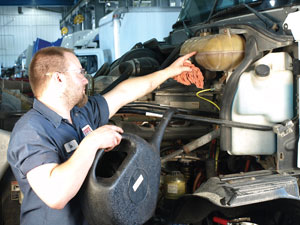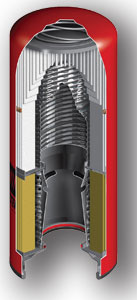Filters! Everything that goes into an engine goes through at least one. The air that goes into a truck’s cabin goes through one. Fuel, coolant and oil are all carefully filtered. On work trucks with hydraulic systems, the fluid goes through one.
Without filtration, engines and hydraulic systems would likely die early deaths, and driver environments would be far less pleasant than they are. Filters are needed for system protection, but they can fail to perform satisfactorily if they are improperly spec’ed, handled or maintained.
Air filters
“This is the filter that gets wasted the most,” said Darry Stuart, president and CEO of DWS Fleet Management Services. “For the most part, fleets do not follow air restriction indications in favor of their personal feelings.”
Could it be that the industry has made it too easy to maintain air induction systems? Effective air filtration is certainly important for the life of a diesel. It didn’t take long for engineers to learn that even a small amount of dirt can do tremendous harm to an engine. Turbochargers, piston walls and bearings are all susceptible to damage.
The earliest diesel engine air filters were essentially packets of steel wool soaked in oil through which intake air passed. Cleaning them was not an easy chore. The introduction of pleated cellulose filter cartridges designed to be replaced instead of cleaned has made maintenance much easier—maybe too easy if technicians too often visually inspect a filter to decide if it should be changed. An air filter may look too dirty to be reinstalled for additional use, or it may well look to be in good enough condition to be used for many more miles, even when its air restriction will cause poor engine performance.
The only effective way to decide if an air filter should be changed is by using an air restriction gauge. Stuart said, “Most people don’t use air restriction as a guide for changing filters, and they should. When they don’t, they waste money. It’s easy to do, but many technicians simply don’t believe in gauges. They believe they can determine when a filter needs changing by looking at it. The goal is to go from PM to PM using air restriction measurements. Don’t touch it. More harm can be done by taking an air filter apart to look at it than by leaving it alone.”
Not everyone agrees on the expected life of an air filter. Baldwin Filter, for example, recommends that air filters be changed at least once annually, no matter what their restriction readings are, because of the possibility of physical damage due to vibration or water ingestion. Stuart said, “By doing that, they’re throwing away money. I had a refuse fleet that was changing them at every PM. Now, by checking and changing by air restriction, they went from using 40 per month to less than 20 all last year. But don’t wash them. It’s not worth trying to extend the life of a $40.00 filter and losing a $10,000 engine.”
Coolant filters
Decades ago, engine manufacturers said that almost half of all diesel engine failures were caused by cooling system problems. Then cooling systems improved, as did other systems. Regardless, engine manufacturers still say that almost half of all diesel engine failures are caused by cooling system problems. Clearly, along with the many advances in coolant and cooling system technologies, other problems developed.
These problems can be minimized, but first a bit of history. Water worked well as a coolant until freezing temperatures were encountered. The addition of methanol helped, but the low boiling point of the mixture resulted in less than adequate cooling. Replacing the methanol with ethylene glycol, because of its high boiling point and low freezing point, solved the problem. Propylene glycol has gained popularity because it is much less toxic than ethylene glycol. Then came the introduction of organic acid technology to improve the protection of the engine’s cooling system. Add to this various supplemental coolant additives (SCA) that can only be used with particular antifreeze formulations, and one can see how the chemistry used to solve problems might cause others. Now add to the mix coolant filters that introduce SCA into cooling systems all at once, over a prolonged time period or not at all.
The solution is to make certain you follow your engine manufacturer’s recommendations. In addition, the American Society of Testing and Materials (ASTM) has developed standard testing procedures that can determine the compatibility of various products. Information regarding the results of such tests is available and well worth requesting from your antifreeze supplier.
The use of cooling system filters is highly recommended to remove debris, core sand and combustion by-products from the coolant. Scale buildup on engine walls can dramatically decrease heat transfer into the coolant. The use of filters designed to slowly introduce a controlled amount of SCA into the system can help control scale buildup and decrease cavitation erosion of cylinder liners. Enviro-Cool also manufactures a spin-on filter that contains a chemical cleaner designed to clean the internal surfaces of an engine’s cooling system.
Lube filters
It wasn’t too long after diesel engines equipped with no filtration were put into commercial service that both users and manufacturers realized that internal engine cleanliness was directly related to engine life. People began adding filters to clean fluids being used by an engine, particularly the lubricant. Cleaner lubricant resulted in longer engine service life. And the filter industry was created.
First came full flow filters. Then we saw both full flow combined with bypass filtration. Spin-on full flow filters followed. Then came full flow and by-pass systems combined in a single unit. Filters keep getting better, as does the lubricant that goes through them. Much of that development has been the result of new engine technology combined with fleet managers, in a desire to save money, demanding the ability to extend preventive maintenance intervals.
The supply side of our industry has responded extremely well to both of these issues. New engine technology, particularly changes required to comply with escalating emissions regulations, imposed tremendous demands on lubricant suppliers. They did the job, and well-known filter suppliers kept pace.
Today’s lubricants, when properly spec’ed and used with quality filters in accord with engine manufacturers’ guidelines, can help fleets extend drain intervals to lengths formerly unattainable. Mark Betner, heavy-duty lubricant product manager at Citgo Petroleum, said, “Various filter designs, by their inherent design, can survive the hostile environment of an engine’s lubricant system longer than others.”
Problems, however, can arise when fleet managers try to push the limits of product capabilities. Betner said, “We get a lot of people wanting to know how long they can go on our oil. Sometimes they fail to understand all of the factors that impact a safe oil change interval. We always become concerned when filter manufacturers claim one can extend drain intervals solely on the basis of their filter’s capability. Too often, you hear claims like, ‘My filter will trap more soot or particulate material.’ One of the factors certainly is the filter, but it’s only one of the factors.”
Soot particles are sub-micron in size and, after an oil change, soot particles are largely kept apart by the oil’s dispersant additive. As the oil ages, however, its soot load may reach a level that the oil can no longer handle. The natural tendency of the soot is to agglomerate and the dispersant capability of an oil can become exhausted over time. The oil at this point has become the weak link in the process.
| Filters: standard or long life? |
| Both long life and standard filters for heavy-duty air and lubricant systems are available from most major filter suppliers. Long life filters, according to Paul Bandoly, manager of technical services and customer training at Wix, must have two attributes to separate them from standard designs:
• Durability—The filter must be made from materials that are physically capable of surviving through a long service life. For example, in the Wix filter line-up, the media of its standard lube filter is made out of high performance cellulose. While this will provide excellent service during a normal PM interval, it is not recommended for use in an extended oil drain program. The company’s XD line, however, is designed specifically for extended service. The media in the XD’s full flow section is a fully synthetic material that is wire-backed for durability. Bandoly said, “It is physically capable of going the distance.” • Capacity—A filter that is intended for extended service must have the ability to hold all the contaminants that it will remove during its service life. If a filter’s effective capacity is reached, however, it needs to be replaced regardless of the length of its service. No matter what kind of air filter you might be using, long life or standard, always change the element based on air restriction as measured by a gauge. Bandoly said, “You can’t simply look at it, and you can’t clock it.” An extended oil drain interval program does not mean that you can ignore the truck between oil drains. Safety and cooling system checks need to be done to ensure these items, as well as others, are being maintained properly. Bandoly, however, points out advantages offered by an extended oil drain program: • A reduction in the use of materials—both oil and filters |
If this occurs, the filter will trap more contaminant because the soot is clumping into sizes that cannot easily pass through the filter. The oil and filter must work together to achieve optimum performance.
“One point of view is that filter service life is at the mercy of the oil’s dispersancy capability,” Betner said.
He also voiced a concern related to claims about replenishing an oil’s additives saying, “My concern is not that the process can’t work, rather, how can we know that it is working? If a supplier has data to support the claims he makes, so be it. But how does one know what to put back into the oil, and how does one know if the original chemistry of the oil has been affected? Oils are manufactured to a very narrow band of licensable formulation. If you introduce aftermarket additives, you may have substantially changed what was made under the formulation agreement.”
What to do? Follow your engine manufacturer’s recommended change intervals unless you have, through a formal oil analysis program, determined that an extended drain interval is safe for a particular make and year engine in your particular application. Even then, talk to your engine manufacturer’s field representative.
If you do that, might you be changing filters too often? Quite possibly. Stuart said, “This is one filter from which we often don’t get maximum utilization because we can’t check its flow restriction. Many of the filters we change still have plenty of capacity left. Basically, it’s ‘safe’ to change the filter at every PM. Maybe, sometime in the future, engines will be able to measure restriction automatically.”
Fuel filters
These are not like your daddy’s fuel systems! They’ve changed, and for the fuel injection systems in today’s engines, effective filtering is more important than ever. Unfortunately, dirty fuel is all but a certainty and must be dealt with. Don’t expect your diesel fuel to be as contaminant-free as the engine lubricant you use. It’s made out of heavier crudes and API standards allow it to contain a level of contaminants unacceptable in lubricant oils. You can expect to find particulates, precipitates, high levels of wax, water and micro organisms. By now, you should be concerned about adequate fuel filtration.
Today’s engines, however, with their high pressure fuel injection systems, can be quickly damaged by dirty fuel. Stuart said, “Diesel fuel needs to be cleaner today than ever before. I don’t think the filters being used currently are big enough. They need to be bigger to get from PM to PM. You can’t do that with standard filters.”
While standard fuel filters are designed to absorb the water contained in fuel, the use of fuel-water separators is a good idea. Too often, condensation that builds up in onboard fuel tanks and is not drained frequently enough.
Also, use a filter with the micron rating recommended by the engine’s manufacturer. There are people who will use a 10 to 15 micron filter instead of one with a three to five micron rating to get a longer life. Stuart cautioned, “Doing so will put you in harm’s way. Don’t trade micron rating for filter life.”
Finally, be sure to consider your fleet’s fuel storage facility as an integral part of your trucks’ fuel systems. Stuart said, “One of the most important filters in a truck facility is the one on the fuel dispensing pumps. Filter the fuel before it gets into the vehicle.”
Today’s filters will provide excellent service if you spec the correct items based on an understanding of exactly how they need to perform in your operation, then make sure they are properly maintained.
Coolant Filtration
According to Donaldson Co., an estimated 40% to 50% of engine down-time is due to coolant system failure. This is more than just annoying, because most coolant system failure is avoidable. And with today’s diesel engines putting out more heat, cooling system care has become even more important than before. Your engine coolant battles rust, scale formation, acidity, foaming, silicate drop-out and debris while it works to transfer heat and maintain the right operating conditions for optimal fuel economy. Two filtration solutions are available for light and heavy EGR engines with SCR emissions devices. OEMs using heavy EGR coolant systems will be seeing increased thermal cycling and accelerated coolant additive depletion. Coolant conditions may need to be checked more frequently to ensure proper coolant chemical balance.
It’s critical that you understand the exact make-up of coolant in your engine—the chemical is very specific to the job and operating environment.
The filter maker goes on to say that as you consider options, think about selecting a fully-formulated coolant that meets either the Technology & Maintenance Council (TMC) RP 329 or RP 330 specifications. New glycerin formulas that meet the specifications use non-toxic glycerin derived from renewable sources to effectively extend service intervals and provide ultimate protection in a greener product.
Coolant testing should be done at least twice annually or when major coolant loss occurs, Donaldson reminds. Coolant systems are referred to as closed loop systems with the filter operating in a side loop to the main flow. This means that a small percentage of glow goes through a filter that is designed to capture large contaminants. Coolant filters intended to maintain additive levels have an internal baffle with a small hole to control the rate of additive chemical release into the system.
Periodic drain and flushing to clean a system is important because while coolant filters capture large contaminants and release additive chemicals into the system, the sediment can accumulate in the coolant system. These sediments act as an insulator, keeping heat in and preventing heat dissipation.


